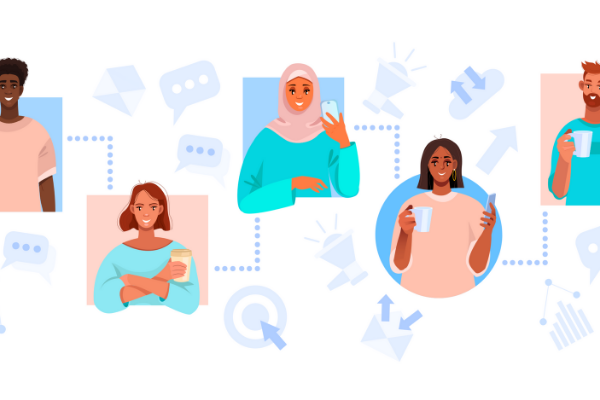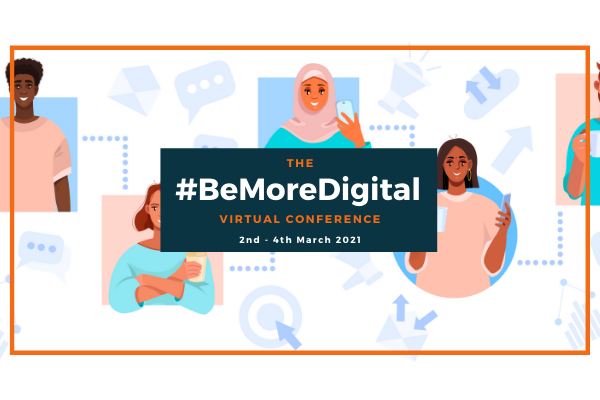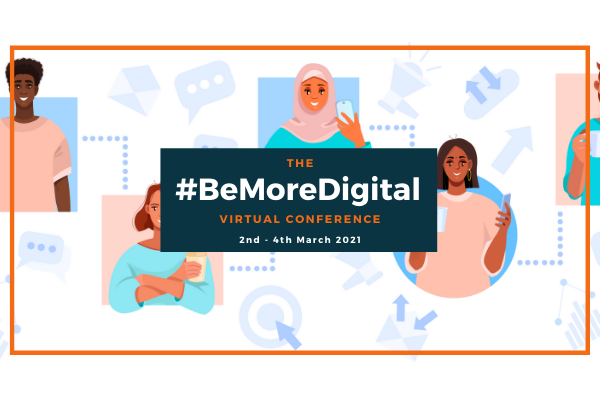Insights
INSIGHTS
All Topics
#BeMoreDigital Virtual Conference 2021: recap of day three
04 Mar 2021by Aidan Paterson
Find out what happened on the final day of the #BeMoreDigital Virtual Conference 2021
Well, that flew by!
Today was the final day of the 2021 #BeMoreDigital Conference. Our first fully virtual annual conference broke attendance records, as users from charities around the country joined us for a programme of digital learning comprising twenty webinars and four workshops. We even made our first foray into virtual networking, which was a great success.
Here’s our recap of the day’s highlights.
The third and final day of the #BeMoreDigital Conference 2021 kicked off with a welcome video featuring Charity Digital CEO, Jonathan Chevallier.
Jonathan recapped the last two days of the conference and introduced the two streams for the day – Digital Service Delivery & Operations and Digital Fundraising.
Then our hosts for the day, Charity Digital’s Chris Hall and Lisa Chomette, took the reins and kicked off the day’s sessions.
Digital Service Delivery & Operations
The first session of the day in this stream was ‘Building a digital strategy to innovate, automate and accelerate’ – sponsored by Phoenix. Andrea Cowell (Account Manager at Phoenix Software) was joined by Trevor Kerr (Head of Digital at Together Trust) for a discussion of digital transformation.
This webinar explored building a new digital strategy from scratch during a pandemic and getting people set up with the basic digital tools they need for remote working and service delivery.
Phoenix gave an overview of the obstacles they’ve seen the sector face and what lies ahead. They explored a charity case study to find out how Together Trust used digital solutions to move their services online during the pandemic. The session explored the many facets of transformation that charities need to consider, such as security, user adoption, productivity, automation and cost optimisation.
One of the key takeaways from the sessions is that there is no set pace for this process. Transformation sometimes happens slowly. It is important to be aware of the needs of the people you are asking to change their processes and to be flexible and make allowances to accommodate them. Trevor shared the story of how ¾ of the staff at one of Together Trust’s residential properties became ill with COVID-19 at the same time. When emergency situations like this arise, it is not the time to start asking people to change their processes and ways of working!
The session also explored the importance of making sure your processes and platforms are fully-integrated and working well together.
The next session in this stream was ‘Is digital working for you, or are you working for digital?’ - a webinar on digital service delivery delivered by Julie Bishop (Director at the Law Centres Network).
When building a programme of digital service delivery, it’s important to prioritise the needs of your service users and staff. With so many options for splashy new tech, it’s easy to get caught up in the excitement. But taking a step back and reviewing your data and processes is the best way to make digital work for you and your service users, rather than the other way around.
The Law Centres Network are several years into a digital transformation journey. This session recapped this journey and shared their learning and experience.
The problem they were facing was that their digital infrastructure was outdated. This was compounded by the fact that while funding was down, user expectations were higher than ever before.
They learned that digital transformation is about leveraging the power of a digital framework across an organisation to learn and to think again. They were able to refashion processes and services based on what service users and staff reported would work best for them.
In this way, they adopted a people-first approach to digital transformation. They identified problems that needed solving and built up from there. They learned that any solution they developed should be simple and easy enough to use for anyone with a working knowledge of digital to pick it up and get started. The Law Centres Network resolved to use third party tools and software, make as much as possible reusable, and only develop new solutions where necessary.
After a short break, we were joined by long-time Charity Digital collaborator and audience favourite, Cub Llewelyn Davies (Charity Sector Lead) for the NCSC’s session ‘GDPR three years on: where is the sector at now?’
GDPR was the hot topic in the sector and beyond when it came into effect several years ago. Three years down the line, this session explored what it means for the sector, and what charities need to do in order to keep their data secure?
The National Cyber Security Centre presented their GDPR Security Outcomes, written jointly with the ICO. These outcomes were designed to help you to understand whether you are still taking appropriate measures to secure your data.
Cub shared a lot of valuable learning in this session. He reiterated the importance of having processes in place to manage data at all stages of its journey. This includes not ignoring the human element behind the majority of data breaches. Sometimes people leaving an organisation under difficult circumstances may take data with them. This risk needs to be mitigated and planned for.
He also covered the important role that technology plays in keeping data secure. Identity and access control is one of the key methods of securing data. Not everyone needs access to all data – this can allow you to limit your exposure. The session also highlighted the importance of setting up automated monitoring for breaches and logins.
One of the key points that Cub covered was that organisations can minimise the impact of breaches by acting swiftly and decisively. Restore systems and services and learn lessons for the future. Response and recovery planning for this begins before a breach occurs so that you are ready to respond. Keep these plans up to date!
The next session was ‘How one charity partnership is bridging the digital divide’. This session was conducted by Helen Mee (Head of Charity Operations at The Clare Foundation) and Chris Lewis (Co-Founder, COO and Global Cancer Influencer at Your SimPal).
Charity partnerships were a hot topic in the sector throughout 2019, but seems to have lost some momentum to topics like digital fundraising and remote working over the course of the pandemic.
But in reality, partnership and collaboration between charities have never been more important, which this positive and interesting session made very clear. Helen and Chris shared their experience of working together to empower people in Buckinghamshire with digital technology, as well as how they plan to grow and scale the scheme in 2021.
The two organisations had similar and overlapping missions, so they were able to work together. They empowered digitally excluded service users with devices (smartphones with 6-month pre-paid sims, with unlimited calls and texts) so that they could meet their basic digital needs, such as keeping in touch with friends and family and accessing vital services over platforms like WhatsApp and Zoom.
The pilot scheme helped the two organisations to discover what people really want from a device. They learned that a tablet may be more user-friendly for older service users with visual impairment than a smartphone.
It is very easy to forget, on a day like today when we come together virtually, that not all people in our society are so fortunate. This session raised some important questions, such as: how do you include the digitally excluded? With working and learning from home so prevalent, how do you help and connect people who have one device between a family? The work of The Clare Foundation and Your SimPal demonstrated an inspiring way forward.
The last session in this stream was ‘Upscaling your digital service delivery during challenging times’. This was a roundtable panel discussion, with speakers from a number of organisations. The speakers were Hannah Page (Marketing & Communications Manager at The Association of Charitable Organisations), Jessica French (Development Manager at CABA), Trudie Clements (Director at ABTA LifeLine), Aidan Jones (Chief Executive at Relate) and Li-Anne Quinn (Marketing and Communications Manager at Foothold).
This was a great panel to end the day on, as it covered some of the key themes of the conference. Having to rapidly upscale services during 2020 was an experience that many charities shared. Where services were once delivered face-to-face, charities had to figure out digital alternatives. Continuing to deliver their support to beneficiaries remotely was vital The Association of Charitable Organisations (ACO), which represents nearly 120 charities.
In this panel discussion, we heard from four charity members who all worked hard to deliver remote services this year. They discussed their varying experiences, approaches, and learnings from the process of digitisation. The panel also discussed overcoming resistance and supporting people with lower levels of tech proficiency by fostering a culture of digital support within the organisation.
A lot of organisations went into COVID with the question of ‘when will this end?’ at the front of their mind. There was an assumption at the beginning of lockdown that things would go back to normal quickly – now we are seeing the idea that things will never return to ‘normal’. But we have an opportunity as a sector to change things for the better.
Digital Fundraising
The Digital Fundraising stream kicked off with an Enthuse webinar on ‘How the Royal Opera House increased donations by over one-third’. Louise Tullin (Marketing Director at Enthuse) and Lauren Grubert (Fundraising Manager at The Royal Opera House), started by looking at how online donations have changed during COVID-19.
They discussed some important patterns, such as increased online donations across all age groups and a general diversity of donations across national and international locations.
The increase in online donations has had a profound effect of fundraising. Lauren and Louise said that, according to research, 37% of online donors do not remember the name of the charity they donated to. The likely reason is that online donors tend to look at the cause rather than the charity and they tend to donate quickly without recognising branding.
Louise and Lauren offered practical advice to charities hoping to increase online donations and keep their charity in donor’s minds. They used the Royal Opera House’s achievements as an example of succesful fundraising.
Louie and Lauren said charities should, among other things, ensure they have clear impact statements on websites, use consistent colours throughout the user journey, ensure the donation process is easy and personal, and continue to test and optimise donations by examining the data and making changes based on data insights.
Clare Sweeney (Digital and Direct Fundraising Consultant at Keepace Consults) then took the reins with her important webinar: ‘Legacy giving: the myths, the facts, and everything in between’.
Clare set the tone with a simple statement. She said that the market for legacy giving has massively increased in recent years, but charities are still failing to devote adequate attention to legacy, instead prioritising short-term fundraising efforts.
Clare explained that charities only need to designate a minimal amount of resources to successfully promote legacy giving. She said that it was as simple as ensuring legacy is included in communications and conversations. It’s therefore a relatively easy and cost-efficient process, and one that can prove financially beneficial in the long-term.
So how should charities approach donors about legacy giving? Clare offered advice around sensitivity, suggesting that sensitivity around legacy giving often rests with the charity, not the potential supporter. She said that charities need to ensure the message remains appropriate, which means clear and concise communication, always emphasising positive elements of charitable donations. Legacy giving should be about life, not death.
Clare mentioned an important new digital tool that helps with legacy fundraising. Donors are often keen to join a community and share reasons for supporting a charity, which is difficult with long-term donations. Charity Intentions fills that gap. It provides a digital space where supporters can share their stories and let charities know they intend to leave a gift in their will.
Next up was Nathan Pinkey (Director at People’s Fundraising), presenting an informative and practical presentation on ‘Your next generation digital fundraising toolbox’. Nathan started the session by exploring five important elements of digital fundraising:
- Developing supporter relationships through branding and communications
- Engaging supporters through diversity of tools
- Knowing your supporters through data and data ownership
- Ease of integration into your overall fundraising toolbox and back office
- Understanding and managing total cost of ownership
Nathan explained how People’s Fundraising improved the user journey on the Just 4 Children website. People’s Fundraising ensured the site was homogenous, aligned branding, added consistency in colour schemes to phraseology, and harnessed the power of data.
Nathan concluded with an important message, which is worth repeating in full. He said that charities must ensure their next generation fundraising toolbox places brand at its heart, incorporates a breadth of fundraising tools, and enables timely data insights.
Following that message, Nathan said, charities can foster strong supporter relationships, increase engagement, and ultimately generate greater recurring revenue.
We moved on to a panel discussion, ‘Getting creative with digital fundraising’, which was hosted by Claire Tavernier, Head of Trustee Board at Charity Digital.
Our excellent panellists Kirsty Alexander (Individual Giving and Legacies Manager at ShelterBox), AtharAbidi, (Head of Social and Digital Activation at the British Heart Foundation), and Matt Smith (Senior Consultant at Brain Tumour Research), each shared their experiences of creative fundraising, which provided heaps of inspiration for charities.
Matt talked about the 10,000 steps campaign, for example, which has been run through a Facebook group. Brain Tumour Research asked people to walk 10,000 steps every day throughout the month to support vital research into brain tumours. Using the Facebook platform had various benefits, Matt said. It allowed users to chat with each other, share their experiences, and offered ample opportunities for important data insights.
Kirsty explained how ShelterBox created an online book club, where everything is digital – apart from the hardback books sent through the post. Kirsty said that ShelterBox had recruited more than 3000 book club members. The book club helped the charity shift from one-off donations to a regular donation stream.
Athar spoke about a partnership the British Heart Foundation made with Omaze. The two parties launched a prize draw to win a £3 million house in London. Athar mentioned some of the challenges the charity faced, including addressing potential criticism from the public, working with partners, and using social media to publicise the fundraising campaign.
The final session of the day was presented by Kellie Stewart (Head of Communications and Marketing at The Sick Children’s Trust). This webinar, ‘The Sick Children’s Trust’s online Auction House – what they learnt from their first digital event’ discussed how the charity quickly adapted after the arrival of COVID-19.
Kellie explained how the charity pivoted to virtual events, using the example of an online Auction House. Kellie shared details of how the charity prepared for the event. She explained how the charity sent out automated and targeted emails, promoted the event on social media, offered innovative and on-trend prizes, and used celebrity contact (including Michael Crawford and Anton Du Beke!) to increase fundraising and raise awareness.
Kellie concluded by describing some of the lessons the Sick Children’s Trust has learnt through the process of launching the online Auction House. She explained how the charity has learnt to reach a larger audience, understood the importance of being agile, gained better audience insight, and ensured greater focus on timing for the future.
Sick Children’s Trust is launching another online auction in 2021, which will take some of the above lessons and further improve the fundraising event for next year!
Find out more
We have recorded many of today’s sessions and will be releasing them over the next few weeks – so do not worry if you missed any. Be sure to check out the Charity Digital website for updates.
Aidan Paterson
More on this topic
Recommended Products
21 Nov 2024by Josie Sparling
How one charity more than doubled its event’s incomeSponsored Article
21 Nov 2024by Ioan Marc Jones
How to make Christmas cards and fundraise for charity
Our Events
Charity Digital Academy
Our courses aim, in just three hours, to enhance soft skills and hard skills, boost your knowledge of finance and artificial intelligence, and supercharge your digital capabilities. Check out some of the incredible options by clicking here.


















